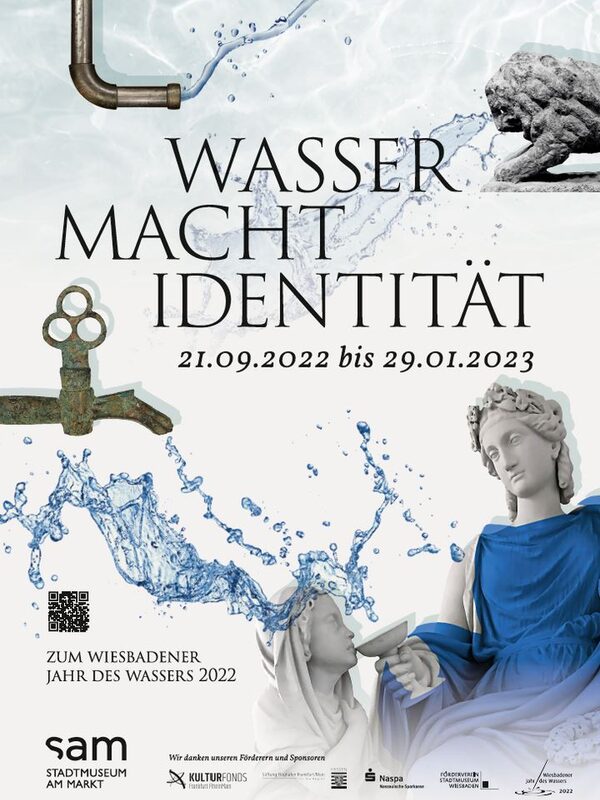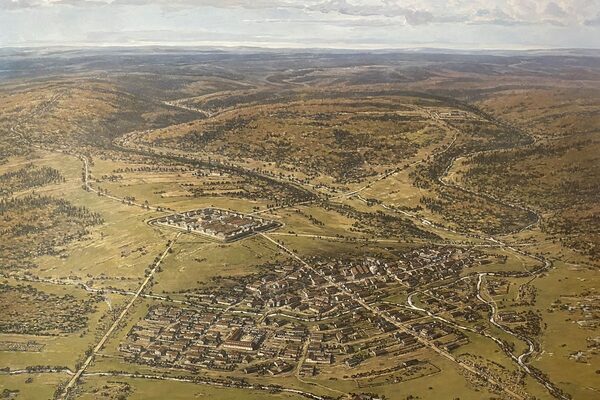Water Power Identity
As part of the "Wiesbaden Year of Water" 2022, the special exhibition "Water Power Identity" at sam - Stadtmuseum am Markt - highlighted the cultural-historical side of Wiesbaden's bathing tradition.
The focus is on its beginnings in Roman times and its reception around 1900, when the so-called "world spa town" experienced its second heyday.
Thanks to its hot springs, Wiesbaden is the only city in the state of Hesse that has been continuously inhabited since ancient times. This makes it the oldest city in Hesse and, together with Aachen, the first spa city in Germany!
The naturally hot water in today's Wiesbaden has probably been used since the Palaeolithic period around 25,000 years ago. Shortly after the arrival of Roman troops on the Rhine, the region experienced its first heyday from 6/15 AD. The hot springs of Wiesbaden were very important for the bathing culture and religious cults of the Romans, so that the city became known nationwide under the name "Aquae Mattiacorum".
Roman bathing facilities were soon built in what is now the city center, which became known as far away as Rome. Ancient writers report on the hot waters in "Aquae Mattiacorum" and that the spring sinter obtained there was traded as far as the capital of the empire. Roman women used it to dye their hair. Roman tombstones and votive stones bear witness to the cultural diversity that prevailed in Roman Wiesbaden at the time.
The "rediscovery of antiquity" around 1900 was a bridge to modern times and showed the importance Wiesbaden attached to its Roman (bathing) tradition, how this was expressed in the public consciousness and ultimately in the cityscape. For example, Wilhelm II was greeted with the words "SALVE IMPERATOR" ("Greetings, Emperor") during his visits to Wiesbaden and the Roman city wall, known as the "Heidenmauer", was repaired in 1902 in a manner typical of the time. Ancient thermal baths were also the model for the Kaiser-Friedrich-Bad, which was built in Art Nouveau style between 1910 and 1913.
On display were objects from the important Nassau Antiquities Collection (SNA), which is owned by the Wiesbaden City Museum Foundation, as well as exceptional loans.
Oil painting by André Brauch
The oil painting by André Brauch shows us a view of ancient Wiesbaden "Aquae Mattiacorum" on an autumn afternoon around the year 120 AD and depicts important locations. The troops from the stone fort on the Heidenberg/Schulberg have already withdrawn to the Limes. Individual buildings are being dismantled, while the seat of the camp commander (praetorium) is being converted into a workshop (fabrica).
In the course of the 1st century AD, a civilian settlement with three large bathing facilities (thermal baths) developed at the foot of the fort. They were located in the area of today's Schützenhof and Adlerquelle as well as at Kranzplatz. During this period, Wiesbaden also rose to become the capital of the administrative unit Civitas Mattiacorum. It is possible that the forum, which is currently under construction, was located on today's Mauritiusplatz. The large baths on Kranzplatz were also expanded.
The oil painting is offered in sam as a poster. A postcard of the painting is available both at sam and online.
Accompanying brochure
A brochure has been published to accompany the exhibition (price 9.80 euros). This can be purchased at sam.
Wiesbaden Photo Days 2022
Publications
sam - City museum on the market
sam - Stadtmuseum am MarktStiftung Stadtmuseum Wiesbaden
Address
65183 Wiesbaden
Arrival
Telephone
Opening hours
Tue to Sun 11-17 h
Thu 11-20 o'clock
Administration
Wiesbaden City Museum Foundation
Bierstadter Str. 1
65189 Wiesbaden

